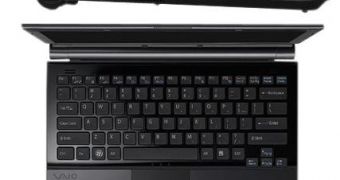Sony Vaio series have always been fashionable. From aspect to quality, Sony managed to deliver the fashion equivalent of a stylish piece of clothing. The Vaio TZ191N notebook could not be an exception to the rule and Sony managed to keep it up to nowaday's digital trends.
Under the black carbon-fiber case, there beats an Intel Centrino Duo processor that runs at 1.2 GHz with a bus speed of 533 MHz, 2GB DDR2 SDRAM and a double-layer DVD writer. The display is made of a WXGA active-matrix TFT color LCD screen that delivers an extremely sharp image at a maximum resolution of 1,366 by 768. The notebook looks breath-taking and there's more thrill to it, since it only weighs about one kilogram with batteries or 1,5 kilograms if you plan to take the power adapter with you.
Sony's Vaio TZ191N has switched to solid-state drive (SSD) storage. The 32 GB SSD consumes less power than a standard laptop HDD, not to mention that it runs cool and features extremely fast access times. The single downside to the SSD approach is that the storage capacity is the average of what a laptop could deliver five years ago. Moreover, things are going to shrink for you, as the majority of the SSD will be taken up by the operating system and the additional software, which leaves you no room for music, photos and other multimedia stuff. As for the high definition content, you may wave your hands goodbye.
The storage space issue can easily be corrected by purchasing a fast external hard drive, but this would spoil the minimalistic weight of your laptop bag. Moreover, investing some extra money in external storage might make you run amok because it is supposed you have already paid enough dough (around $3100) for your priceless Vaio.

 14 DAY TRIAL //
14 DAY TRIAL //